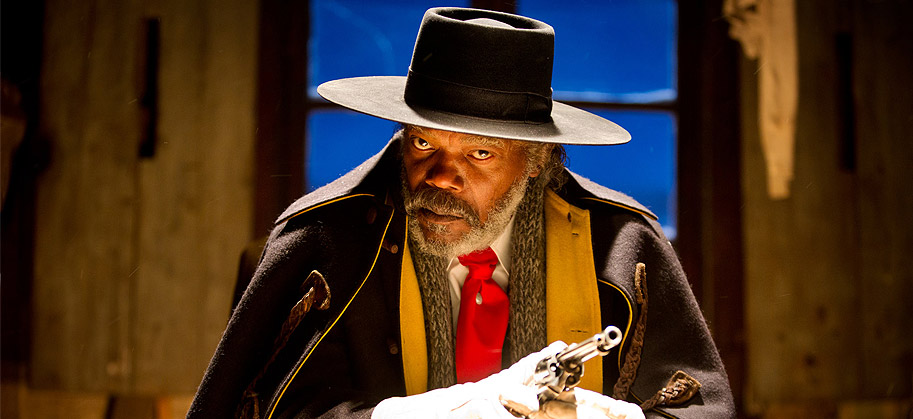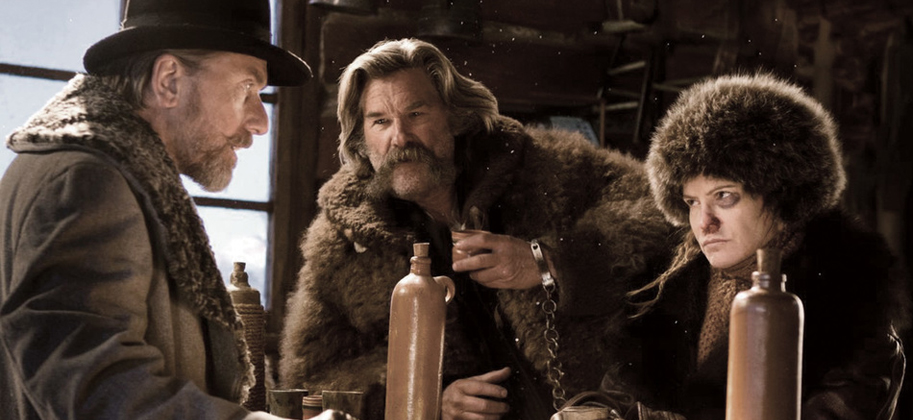Quentin Tarantino got the stagecoach wheels rolling on The Hateful Eight when he announced it less than one year after Django Unchained hit theaters. In fact, the announcement wasn’t the only thing that was close. The Hateful Eight actually started as a sequel to Django, with parts of it stemming from an abandoned novelization of his revisionist western.
For this western, Tarantino would use western TV show tropes–chiefly the bottle episodes where a band of vigilantes took the lead hostage–as a launching point. He thought, “What if I did a movie starring nothing but those characters? No heroes…Just a bunch of nefarious guys in a room, all telling backstories that may or may not be true. Trap those guys together in a room with a blizzard outside, give them guns, and see what happens.” And what happened was a lot of anger, a lot of snow and a lot of vomit.
And it also never happened. In January 2014, less than two months after unveiling his project, the script leaked. Tarantino strongly considered hanging up the project higher than Daisy Domergue. He thought about turning it into a novel before settling, at least temporarily, on doing a live reading. And so in April 2014, Tarantino hosted a live reading of the screenplay’s first draft with a lot of what would become the final cast, albeit adding Amber Tamblyn as Daisy. Eventually, Samuel L. Jackson convinced Tarantino to just make the movie.
Who leaked the script–a situation that left Tarantino “very, very depressed”–was a bigger question than Who poisoned the coffee? Tarantino narrowed it down to a handful of people, including stars Bruce Dern, Michael Madsen and Tim Roth (who already played the fink in Reservoir Dogs) and more or less ultimately blamed shifty agents. The culprit remains unknown to this day, but it would be the ultimate “Dernsie”…just saying!
With the go-ahead from Jackson, Tarantino set about casting the titular octe.
And so:
Samuel L. Jackson (their sixth collaboration) – Major Marquis Warren
Kurt Russell – John Ruth aka The Hangman
Jennifer Jason Leigh – Daisy Domergue, described as “Susan Atkins of the Wild West”; r
Walter Goggins – Chris Mannix
Demián Bichir – Senor Bob
Tim Roth – Oswaldo Mobray; he’s later revealed to be Pete Hicox, later confirmed to be the great-grandfather to Michael Fassbender’s Lieutenant Archie Hicox in Inglorious Basterds
Bruce Dern – General Sandford Smithers
Michael Madsen – Joe Gage
At one point, Viggo Mortensen was attached but had to ditch the film due to scheduling issues. He also previously auditioned for Reservoir Dogs for an undisclosed role.
With a budget pegged around $44 million–which raised exponentially once cameras started rolling–production began on The Hateful Eight in January 2015. And while the shoot wasn’t exactly plagued with troubles, those that did occur were a mixture of those in and out of the crew’s control.
One of the most publicized stories surrounding The Hateful Eight had to do with its shooting method, as Tarantino decided to film it in glorious 65 mm. Cinematographer Robert Richardson (Kill Bill, Inglorious Basterds) uses Ultra Panavision 70 lenses–the widest format available (aspect ratio: 2.76:1). They’re so uncommon that Richardon was under the impression they “no longer existed”. So rare they are, The Hateful Eight would be under one of a dozen movies to use the lenses, the most recent being 1966’s Khartoum, meaning they would have to be retrofitted on modern technology. For cameras, Richardson would also use Panavision 65 HR Camera and Panavision Panaflex System 65 Studio, along with Kodak Vision3 200T 5213 and Vision3 500T 5219 film stocks.
As the weather was harsh, the team had to go through various tests to make sure they would work under the weather conditions. At time, they had to keep blankets over the cameras to protect the fragile equipment. After all, temperatures would plummet to negative 10-20 degrees, which doesn’t make QT’s desired 35-degree sets seem so bad!

Production took place exclusively in Colorado, with much of the action taking place at Minnie’s Haberdashery, the location of which was on a 900-acre ranch. (Some special effects shots had to be done on a soundstage). Another major issue arose from its Colorado locale: the snow was unpredictable and so the shooting schedule would often change based on the weather; Got snow? Go shoot the exteriors! Overcast? Get in the stagecoach! In some instances, the production had to use fake snow, as mother nature can be a real mother.
And so can handling an antique. In the movie, after Daisy finishes a rather lovely rendition of “Jim Jones at Botany Bay”, John Ruth snatches her guitar and smashes it to pieces. Unfortunately, that was not the prop guitar. Unbeknownst to Kurt Russell, it was actually an antique C.F. Martin & Company guitar from the 1870s valued at $40,000. So when Daisy is shocked, it’s also Jennifer Jason Leigh that can’t believe what just happened. The director of the Martin Guitar Museum, who loaned the guitar, said, “Upon inspection of the pieces, we realized that the guitar was beyond fixing…It’s destroyed.” The museum now refuses to loan out guitars to film productions.
But not all musical notes were sour. For the score, Quentin Tarantino enlisted legendary composer Ennio Morricone, who he tried to nab for Inglorious Basterds. In addition to a wealth of memorable soundtracks, Morricone also composed some of his most iconic western scores ever (The Good, The Bad & the Ugly practically defines the genre). Oddly, he hadn’t composed one for a western in over three decades. The collaboration went off without a hitch, although there was some minor controversy after Morricone apparently made disparaging remarks about QT’s use of his music in Django Unchained. Music was also used from The Exorcist II and The Thing, a movie also scored by Morricone and that greatly influenced the visuals of the film. The soundtrack was padded out with songs from The White Stripes, Roy Orbison and Wes Craven’s The Last House of the Left, adding more genuine horror to the film.
With production wrapped, The Hateful Eight could finally be released…in two versions. The roadshow was undoubtedly the big draw. Running 187 minutes, the roadshow version, like the 70 mm presentation, offered a throwback to an entirely different era of moviegoing. There would be an intermission and a physical program that also served as a souvenir (this writer still has his). It was, in other words, an event. But to pull it off, around 100 theaters had to be equipped with the necessary technology for proper presentation.

Oh, and there would be a general release for the peons, with parts cut that don’t change the story, but may not have seemed as grand on your couch. This version was on 2,400+ screens.
Ahead of both releases, The Hateful Eight was hit with its second leak, the same week QT was getting his star on the Hollywood Walk of Fame. This time, DVD screeners got out, threatening its box office numbers. But we won’t blame this one on Bruce Dern! Even still, TThe Hateful Eight pulled in $155 worldwide. Considering the screener incident and an active police protest (they didn’t dig QT attending a BLM rally), it did quite well–even if it did debut at #3 in its wide release behind The Force Awakens and the Will Ferrell/Mark Wahlberg comedy Daddy’s Home. But forget Daddy’s Home–oh, you already did?–and let’s chat Star Wars.
As it turns out, Disney put a stranglehold on the Cinerama Dome in Los Angeles, saying it could only play The Force Awakens and not The Hateful Eight. “They are going out of their way to f*ck me,” said QT. “As far as I’m concerned, let all the entertainment reporters call up Disney, as of now, and ask for their comments about their extortionist practices.”The Hateful Eight did eventually play there, but Tarantino swore off the House of Mouse forever. Can we assume he doesn’t have a Disney+ account?
The Hateful Eight would earn just three Academy Award nominations, the lowest since the one for 1997’s Jackie Brown (not counting Kill Bill and Death Proof, which had zero): Best Supporting Actress (Jennifer Jason Leigh), Best Cinematography, Best Score. The only statue went to Ennio Morricone, winning his first statue in six nominations, becoming the oldest recipient in history at 87. It would end up being his penultimate score, as Morricone died in 2020.
But that wouldn’t be the last of The Hateful Eight. In 2019, Netflix debuted The Hateful Eight: Extended Version which made the film a four-part series that ran 26 minutes longer than even the roadshow version. It, like the roadshow version, had a relatively limited run, staying on the streaming service for under four years.
While reviews were fine, The Hateful Eight stands as one of Tarantino’s worst-reviewed movies. It’s a bit cluttered, a bit overwritten, a bit unmemorable. But there are also moments that feel like self-parody, something even the greatest artists fall into. No matter which version you watch–the roadshow, the general or the extended, it still feels like lesser Tarantino.
But this can be debated endlessly. As for us, we have to go…ol’ Mary Todd is calling.
Originally published at https://www.joblo.com/wtf-happened-to-the-hateful-eight/

